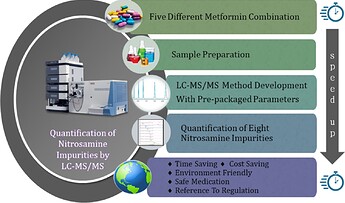Publication: “UHPLC-APCI-TQ-MS analytical method capable of quantifying eight nitrosamine impurities from five different commercially available Metformin formulations with Glipizide, Glibenclamide, Gliclazide, Evogliptin, and Glimepiride” by Solaki et al.
Link: Redirecting
Abstract:
Metformin and its combinations are widely used to treat type 2 diabetes. The drugs commonly used in combination with Metformin are Glipizide, Glibenclamide, Gliclazide, Evogliptin, and Glimepiride. Combination therapy is preferred over monotherapy of Metformin in most diabetics. About eighteen pharmaceutical manufacturers have lately recalled metformin formulation batches from the U.S. market due to N-nitrosodimethylamine (NDMA) impurities based on the food and drug administration (USFDA) guideline “Control of Nitrosamine in Human Drugs.” European Medicines Agency (EMA) and Health Canada have also established guidelines for nitrosamine impurities. Nitrosamines are well-known mutagenic impurities and probable human carcinogens found in combination formulations. Thus, global regulatory agencies require pharmaceutical and formulation manufacturers to complete risk assessments for nitrosamine impurities for patient safety. Therefore, drug manufacturers must develop analytical techniques for monitoring trace nitrosamine impurities. Quantifying nitrosamine impurities in formulations requires modern equipment like LC-MS/MS and great intellect. The present study intends to give a single pre-packaged LC-MS/MS method parameters, including liquid chromatography and triple quadrupole mass spectrometer configuration. This method could quantify eight nitrosamine impurities from five different Metformin combinations (Metformin with Glipizide, Glibenclamide, Gliclazide, Evogliptin, and Glimepiride). The atmospheric pressure chemical ionisation (APCI) was used as an ionisation source, and the mass spectrometer was set to multiple reaction monitoring (MRM) mode for all eight nitrosamine impurities. A unified pre-packaged analytical setup allows analytical chemists to develop a reliable, sensitive, robust, and precise method for quantifying eight nitrosamine impurities from five different Metformin formulations of varying manufacturers. This analytical method saves time, money, and the environment using fewer pharmaceutical chemicals.
